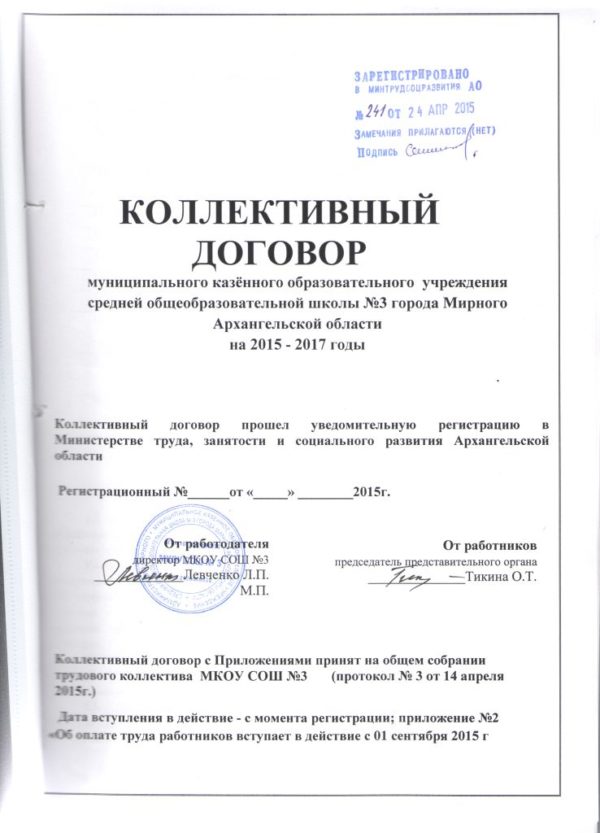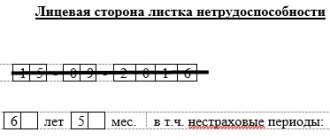What it is?
The main provisions on collective contracts and agreements, the approximate structure and content of the document are prescribed by law in the Labor Code (Articles 40 - 51). Despite this, employers often encounter difficulties when drafting them, since the regulatory documentation stipulates only the approximate form and content of the document, and there is no sample.
Let us turn to the definition of the concept of “collective agreement”:
From a legal perspective, a collective agreement is an act that regulates socio-economic relations in an organization , and its existence is a positive thing for all parties. Such an agreement helps resolve additional issues and also protects the interests of both parties.
If we turn to the question of whether a collective agreement is a source of labor law , then the answer is obvious - yes, it is. This is stated in Article 5 of the Labor Code of the Russian Federation.
What is a collective agreement
Before drawing up this document, both parties coordinate their interests, based on the Labor Code of the Russian Federation.
Many people often wonder why an agreement is needed if an employment agreement or contract is concluded. The difference between these two documents is obvious. The contract is signed by the organization with the contractor, that is, a private individual. This document may contain clauses that infringe on the interests of the performer, if he agrees to this. These clauses are unacceptable in a collective agreement.
In the conditions of the modern labor market, it is rarely possible to achieve justice alone, because one is not a warrior in the field. But collective opinion and dissatisfaction never went unheeded. In addition, the contract/contract is checked and registered with labor authorities, which will not allow infringement of the interests of workers and violations of labor legislation.
Types and validity period
A common question among employers is what types of collective agreements are divided into. This is due to the fact that the concepts of “collective agreement” and “collective agreement” are confused .
The difference between these terms is that a collective agreement implies the regulation of labor relations not in a specific organization, but in an entire industry - naturally, collective agreements are classified into types according to their range of validity.
Since a collective agreement is a local act that operates exclusively within an enterprise, there are no types of it .
The contract comes into force from the day it is signed and applies to each employee, including those who were employed after its conclusion. The document is concluded for a maximum period of no more than three years; at the end of this period it can be concluded again or extended for another three years.
An interesting point is that the law does not regulate how many times an existing contract can be extended , so it is permissible to do this ad infinitum.
From the moment the contract is concluded, the parties are equally responsible for violation of its terms . Responsibility is provided for by law and ranges from warning to fine and dismissal, depending on the violations committed.
Dismissal for failure to perform official duties may also occur. Read more about this here.
Article 43 of the Labor Code of the Russian Federation. Validity of the collective agreement (current version)
1. A collective agreement is an act of urgent effect; at the discretion of the parties, it may be concluded for any period not exceeding three years.
2. The date of entry into force of the collective agreement is determined by the parties and does not depend on any circumstances (for example, on notification registration), with the exception of the will of the parties.
The parties may stipulate the entry into force of the collective agreement:
a) the very fact of signing the contract;
b) the onset of a certain calendar date;
c) the occurrence of a certain event.
3. The parties are given the right to extend the collective agreement for a period of no more than three years. Such a decision must be made by agreement of the parties.
Part 2 of the commented article provides for the right of the parties to repeatedly extend the validity of the collective agreement, which is consistent with the practice of social partnership that has developed both in our country and abroad, and contributes to the stability of collective agreement regulation.
4. The validity of a collective agreement for a circle of persons is determined by the level of its conclusion.
The collective agreement concluded by the employer and employees of the organization (individual entrepreneur) applies to all employees of the organization (individual entrepreneur) regardless of membership in a trade union and other circumstances, incl. mode of operation, nature of labor relations. In particular, it applies to part-time workers, homeworkers, and workers who have entered into a fixed-term employment contract. Similarly, a collective agreement concluded in a separate structural unit covers all employees of the corresponding structural unit.
The collective agreement also applies to employees who started working after its conclusion.
The Labor Code does not provide special rules on the validity of a collective agreement in relation to the head of an organization. Due to the dual position of the manager, who is both an employee and a representative of the employer in collective bargaining, the issue of whether all or some of the provisions of the collective agreement apply to him must be decided by the parties when concluding this agreement.
5. Changing the name of the organization, dismissal of the manager who signed the collective agreement on behalf of the employer, as well as reorganization in the form of transformation do not affect the fate of the collective agreement. Its effect remains.
6. When changing the form of ownership of the organization and reorganization in the form of merger, accession, division, separation, the collective agreement is valid only for a kind of guarantee period - until the end of the reorganization or for three months from the moment of transfer of ownership rights. In this case, the validity period of the collective agreement established by agreement of the parties does not matter. For example, a collective agreement was concluded on January 15, 2012 for a period of three years, therefore, its expiration date will be January 15, 2015. However, in March 2013, reorganization began in the form of division. In such a situation, the collective agreement will remain in force only for the period of reorganization; After new organizations are entered into the register of legal entities and the divided organization is excluded from it, the agreement will lose force.
7. Special rules are established for privatized enterprises. Article 17 of the Federal Law of December 21, 2001 N 178-FZ “On the privatization of state and municipal property”, among social guarantees for employees of open joint-stock companies, limited liability companies created in the process of privatization, also includes guarantees for maintaining the validity of the collective agreement concluded by the privatized unitary enterprise .
Open joint-stock companies and limited liability companies created in the process of privatization of property complexes of unitary enterprises comply with the conditions and are responsible for the obligations contained in the collective agreements that were in force before privatization.
After three months from the date of state registration of an open joint-stock company or limited liability company, their employees (employee representatives), board of directors (supervisory board) or executive body of the open joint-stock company or limited liability company may propose to conclude a new collective agreement or extend it for a period up to three years of validity of the previous contract.
8. When a legal entity is liquidated, the collective agreement remains in effect for the entire period of activity of the liquidation commission.
Comment source:
Rep. ed. Yu.P. Orlovsky “COMMENTARY ON THE LABOR CODE OF THE RUSSIAN FEDERATION”, 6th edition ACTUALIZATION
ORLOVSKY Y.P., CHIKANOVA L.A., NURTDINOVA A.F., KORSHUNOVA T.YU., SEREGINA L.V., GAVRILINA A.K., BOCHARNIKOVA M.A., VINOGRADOVA Z.D., 2014
Content and structure
Although Article 41 of the Labor Code provides a list of the main issues that can be provided for in this document, there is no final list. What exactly will be specified in the contract is determined by the parties independently. It usually contains information on issues such as:
- Issues related to remuneration;
- Amount and procedure for additional payments;
- Conditions under which benefits may be provided to employees;
- Issues related to employee training, recertification;
- Issues related to vacations, as well as work schedules;
- Issues related to labor protection;
- Other questions.
It should be noted that the conditions specified in the contract cannot contradict or violate the norms of labor legislation and other documents.
What is it needed for?
Both parties receive a lot of benefits when signing an agreement. The obvious advantages of having an agreement at the enterprise are:
- The ability for the employer to establish benefits for employees independently;
- A colossal reduction in document flow in the HR department;
- Justification of costs associated with the costs of maintaining employees.
It is widely believed that a collective agreement is signed solely for the benefit of employees, but this is not so - the employer also benefits by concluding it.
Watch a useful video about concluding collective agreements:
Concept
A collective TD is a local legal act that is signed between the employer and the team of employees represented by their legal representatives in order to regulate social and labor relations in the organization.
Such an agreement is not required to be concluded, unlike an individual TD, without which employment cannot be considered official.
Most often it is compiled in large organizations.
The parties concluding a contract of agreement are the employer, represented by an appointed representative (usually one of the representatives of the administration - a manager, head of the personnel department, chief lawyer or a third party) and employees, on whose behalf an elected body acts. They determine the content of the document.
Such a document does not have to be concluded with all employees of the organization; it can be a separate structural unit or branch of the company.
It includes additional obligations and rights of the parties that are not reflected in the individual TD.
Decor
The registration of a collective agreement must be carried out according to uniform rules .
An example of a collective agreement can be downloaded here.
Title page
In accordance with the rules of office work, the sheets of the collective agreement must be stitched and numbered . The title page usually contains general information:
- Full name of the enterprise;
- Document's name;
- Full name, signatures of the persons who entered into the agreement;
- Prints;
- Mark of the registering authority indicating the number and date of registration.
Sample title page:

Applications
Issues that are voluminous and require strict regulations are formalized as appendices to the agreement. These include:
- VTR Rules;
- Regulations on bonuses and remuneration;
- Labor safety instructions;
- The procedure for conducting SOUT.
Depending on the specifics of the organization, other documents may be drawn up as attachments at the discretion of the parties .
Extract
If necessary, extracts can be made from the collective agreement for submission to higher authorities , etc. When drawing up an extract, the necessary part of the contract is copied, on which the details indicated on the title page are duplicated (excluding signatures). In addition, the extract sheets are stitched, numbered and certified by the signature of an authorized employee.
Provided that the collective agreement is drawn up correctly and in accordance with the requirements of labor legislation, due to its presence it is possible to significantly optimize the work with documentation and clarify the rights and obligations of the parties .
If you cannot decide whether a collective agreement is needed in an LLC, keep in mind that responsible employers prefer to have such a document in the organization, although they are not required to do so . If there is no collective agreement at the enterprise, all activities are carried out within the framework of current legislation.
From what moment does the collective agreement come into effect?
In relation to the procedure for the entry into force of a collective agreement, the Labor Code provides for two main options:
- General procedure for the entry into force of the agreement.
- Special order.
The collective agreement begins to operate from the moment it is signed by both parties: the employer and the board of the trade union or simply an initiative group of workers. Subject to the provisions of Art. 191 of the Civil Code, the collective agreement comes into force the next day after its signing.
The agreement may specify other terms for the entry into force of the agreement: for example, the parties may specify a period delayed by 10 days from the date of signing. Thus, the parties to the collective agreement have the right to independently determine the day the agreement enters into force.
In Art. 50 of the Labor Code indicates the need to register collective agreements with executive authorities that monitor the implementation of labor legislation. But regardless of the registration procedure, the collective agreement acquires legal force after signing.








